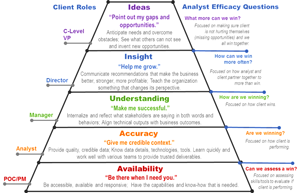
There have been many discussions and conversations about what makes a good digital analyst…what skills, capabilities, education and training are needed for a career path in this industry. In fact, the Digital Analytics Association (DAA) has built out a Digital Analytics Competency Framework which documents the knowledge and skills needed to be a digital analyst.
I’ve been in the interactive space for 24 years, spending my entire career on the agency or consulting side of the business. And because I am someone who always strategically thinks of the consumer/customer first, I wondered what clients believed they needed from a digital analyst. So, I surveyed some clients to get this unique perspective. And from this effort, a Hierarchy of Client Needs surfaced.
First, while I reference the term “client” because I come from an agency or consultancy, if you work at a business or company, you also have internal clients that you might call business stakeholders. They are marketing managers, product managers, customer care managers, and executive team members – your business stakeholders that you, as an analyst, are working to build a relationship with so that you can help to influence business decision making with data. Given this, the Hierarchy of Client Needs is relevant to all of us as we partner together to make better data-driven decisions that increase revenue, decrease costs, increase customer satisfaction or increase institutional knowledge.
The Hierarchy of Client Needs follows the same underlying principle that Maslow’s Hierarchy of Needs address – that the most basic or fundamental needs must be met before an individual will strongly desire the higher level needs.
Foundational to the Hierarchy of Client Needs is “Availability.”
At this level, the client is thinking, “Be there when I need you.” Clients need you to be accessible, be responsive, be available. They need you to have the base know-how and capabilities that are needed for the job. As we think about our day-to-day activities, if we don’t have the bandwidth to take on a new project or the capabilities to do what is requested, then – at the foundation – we are unable to meet this client need and are not in a position to build an influential relationship with this business stakeholder. At this level, the analyst is asking themselves, “Can we assess a win?” Do we have the right tools, people and processes in place to measure success?
The next tier is “Accuracy.”
At this level, the client is thinking, “Give me credible context.” Clients need you to provide quality, credible data. To know the details of the data, the tools and technologies. Be able to work well with others to provide trusted deliverables.” At this level, the analyst is asking, “Are we winning?” Now that we have the right tools and people in place, the focus is on if the business is performing.
The next level is “Understanding.”
At this tier, the client is thinking, “Make me successful.” Clients need you to be able to internalize and reflect on what stakeholders are saying. They need you to be able to align technical outputs with business outcomes. This is also a level that serves as a gateway between an executional relationship to a collaborative relationship. At this level, the analyst is asking, “How are we winning?” Now that we know we are winning, the question is how the business is winning.
The next level is “Insight.”
At this level, the client is thinking, “Help me grow.” Clients need you to communicate recommendations that make the business better, stronger, more profitable. They are looking to you to teach the organization something that changes its perspective. This is a level that shifts the relationship from a collaborative partnership to a strategic partnership. And at this level, the analyst is asking, “How can we win more often?”
At the top of the pyramid is “Ideas.”
At this level, the client is thinking, “Point out my gaps and opportunities.” Clients need you to anticipate needs and overcome obstacles. They need you to see what others cannot see and invent new opportunities for the business. A this level, the analyst is asking, “What more can we win?” What opportunities is the business missing where new growth and profitability can occur?
It’s also interesting to note that there are client roles associated with each of these different hierarchy of needs. At the “Availability” level, the analyst will address the needs of a Project Manager or project point of contact. At the “Accuracy” level, you will address the needs of the Analyst. At the “Understanding” tier, you will address the needs at a Manager level. At the “Insight” tier, you will address the needs at the Director level. And at the “Ideas” tier, you will address the needs of Vice Presidents and C-Level executives.
This Hierarchy of Client Needs is a framework that highlights different client needs that an analyst must address in order to build and strengthen relationships with business stakeholders and successfully influence better business decisions based on data.
